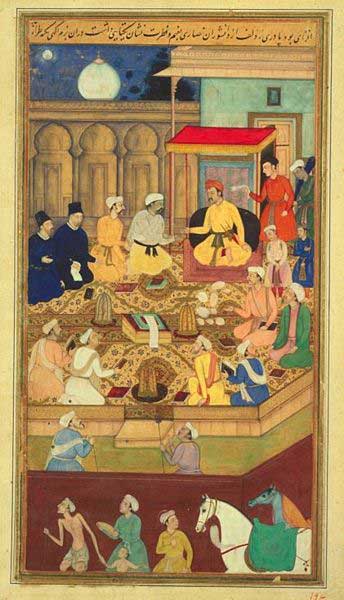IARF’s new (2009) homepage banner
The new page header for the IARF site, soon to be seen on all pages, shows one entrance of the Diwan-i-Khas — the ornate, single-storey Hall of Private Audience of the enlightened third Mughal Emperor of India, Akbar the Great (r. 1556-1605) in his palace & royal city of Fatehpur Sikri. (Visible at right is part of the famous central pillar, a single finely-carved block of stone)
Akbar built Fatehpur Sikri in 1570, in Sikri, the hometown of the Sufi saint Salim Chishti, to honor him for his prophecy of a successor to Akbar (his son the next emperor, Jahangir). Regarded as Akbar's crowning architectural legacy, it remained the empire's capital until 1585.
It shows a combination of influences from Hindu & Jain architecture hand in hand with Islamic elements, reflecting its significance for the history of interfaith endeavour:-
it was here that Akbar had representatives of different religions discuss their faiths.
From - http://en.wikipedia.org/wiki/Fatehpur_Sikri
_________________________________________
'The city rose in less than five years. The chronicles record the incredible speed with which it swelled & prospered: trade blossomed, merchants from all over Asia set up bases and the caravanserai were so packed that a visiting party of Portuguese priests complained of the noise. But as well as a centre of trade, Fatehpur Sikri soon became a philosophical laboratory for Akbar's spiritual enquires. Holy men from all of India's religions were invited to the city to make the case for their particular understanding of the metaphysical, including the party of Portuguese priests from Goa.
'The room where these discussions took place - the Diwan-i-khas - still stands completely intact.... Akbar would sit on silken cushions raised on the central platform - thus proclaiming his position as the axis mundi, the central pillar of the Mughal Empire - as holy men of four competing faiths knelt at the ends of the walkways debating the merits of their conceptions of spirituality.'Akbar's thesis was that "the pursuit of reason" rather than "reliance on the marshy land of tradition" was the proper way to address religious disputes. Attacked by traditionalists who argued in favour of instinctive faith in the Islamic tradition, Akbar told his trusted lieutenant Abu'l Fazl: "The pursuit of reason and rejection of traditionalism are so brilliantly patent as to be above the need of argument. If traditionalism were proper, the prophets would merely have followed their own elders [and not come with new messages]." Taking note of the fabulous diversity of religious beliefs in India - Hindus, Muslims, Christians, Jains, Parsees, Jews & atheists - Akbar laid the foundations for the secularism & religious neutrality of the modern Indian state'.
by William Dalrymple
http://www.independent.co.uk/travel/asia/the-city-of-emperors-565033.html
The Ibādat Khāna (House of Worship)
Tolerant of religions other than Islam, Akbar encouraged debate, inviting religious leaders & philosophers of many faiths from around his diverse empire to his Thursday evening discussions.
The Ibādat Khāna was the meeting house he built for these debates, which started in 1575. Though its exact site within the Fatehpur Sikri palace complex is unknown, some think it was the Diwan-i-Khas.
His conclusion that no single religion could claim the monopoly of truth inspired Akbar in 1581 to propound his Dīn-i Ilāhī ("Divine Faith"), combining mysticism, philosophy and nature worship.
The Victorian poet laureate Alfred Lord Tennyson's poem Akbar’s Dream lauds the Ibādat Khāna, ascribing tolerance & humanity to the emperor's syncretistic faith, while implicitly criticising the intolerance of 19th century British Christianity:
In the king's garden, gathering here and there
From each fair plant the blossom choicest-grown
To wreathe a crown not only for the king
But in due time for every Mussulman,
Brahmin, and Buddhist, Christian, and Parsee,
Thro' all the warring world of Hindustan.


